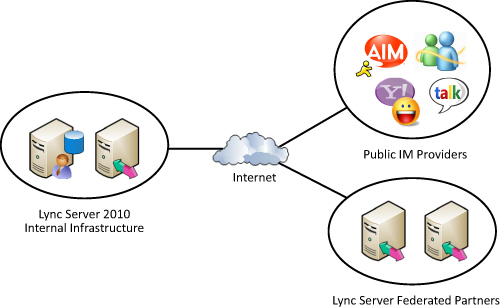Remote Access
One of the strongest advantages
of Lync Server is that it offers users a completely seamless and
consistent user experience regardless of location. Users who travel and
use a hotel’s public Wi-Fi have access to the same features as users in
an office that uses the corporate network. This consistent experience is
provided without a VPN connection or manual client configuration
changes by the user, which allows all features to work from any
location.
A
Lync Server endpoint is aware whether it connects internally or
externally by means of service records (SRV) in DNS, so users don’t need
to make any changes to their client configurations depending on their
locations. When a user is remote, the signaling is performed over the
standard HTTPS port 443, so it is secure and accessible from almost any
remote network.
This feature is similar in
function to the Outlook Anywhere feature, which has existed for Outlook
users since Exchange 2003. Just as users have come to expect Outlook to
function identically whether inside or outside the office, a remote user
has full access to the Lync Server feature set. They can view presence,
exchange IMs, host or attend web conferences, share desktops, or
perform A/V conversations. This even extends to Enterprise Voice users
who can make and receive phone calls with their office numbers from
anywhere in the world across the Internet.
Federation
Federation is a feature
that enables organizations that have deployed Lync Server to communicate
easily and securely across the public Internet. As long as both
organizations have deployed an Access Edge server, federation can be
used to view presence and exchange IMs.
Organizations can also
use federation to participate in web conferences with each other or have
audio and video conversations with one another. Similar to the way
e-mail has become a standard means of communication, federation for rich
collaboration capabilities has emerged as a standard way to conduct
business across organizations.
Note
Federation is not limited to
organizations with only Lync Server, but can also be used with IBM
SameTime or Cisco Unified Presence Server for organizations that have
not deployed Lync Server.
Public IM Connectivity
A special type of
federation called Public IM Connectivity (PIC) enables MCS users to
communicate with contacts using the various public IM networks. Although
many organizations have deployed previous versions of a Communications
Server and support federation, there are still needs to communicate with
public IM contacts at times.
Lync Server supports the following public IM providers:
Additionally, federation to
Google Talk users can be provisioned through the XMPP Gateway Server
role. PIC connectivity provides presence and peer-to-peer IM for all providers, but in Lync Server, peer-to-peer A/V conversations can also be used with Windows Live contacts. Figure 3.4
shows how a Lync server infrastructure can communicate both with
federated partners and the public IM networks across the Internet.

Archiving
For organizations
that have archiving or compliance needs, Lync Server provides the
Archiving Server role, which can capture IM traffic. All archiving data
is saved to a Microsoft SQL Server database and is separate from the
database used for all user services and contact lists.
Archiving can be enabled at
the pool level to capture traffic for all users or it can be enabled on a
per-user basis if archiving needs to done for only a select group of
users. If an organization has no need to capture internal traffic,
archiving can also be configured to log only federated traffic.
Tip
In the event of an archiving
server failure, the administrator has the option to shut down the pool
and user services to ensure the organization meets compliance
regulations.
Monitoring
A key factor in determining the
success of an audio and video deployment is insight into how the system
performs for the end users. Lync Server provides out-of-the-box
monitoring capabilities with the Monitoring Server role. When deployed,
endpoints submit reports when completing an audio or video call, which
are then stored in SQL databases dedicated to call records and
monitoring data.
There are two types of reports collected. One report is referred to as call detail records (CDR)
and it contains information about when the call occurred and what
endpoints were involved. The other is a quality of experience (QoE)
report that contains comprehensive data, including Mean Opinion Scores
(MOS) of various components, which indicates the call quality in both
directions. These reports also identify which subnet the endpoints used
so that administrators can quickly isolate any issues to a specific
device or network segment.
Note
A SQL Server Report Pack is
bundled with the installation media so that administrators have
immediate access to rich reports about how the system is used.
Lync Server also
supports synthetic transactions that are PowerShell cmdlets an
administrator can run, which simulate actions taken by users against the
server. Examples of these transactions are a user signing in, two users
sending IM messages to each other, or a test audio call between two
endpoints. These synthetic transactions can be used to test user
functionality systemwide on a recurring basis or in conjunction with the
Microsoft System Center Operations Manager management pack for Lync
Server, which includes support for the transactions.